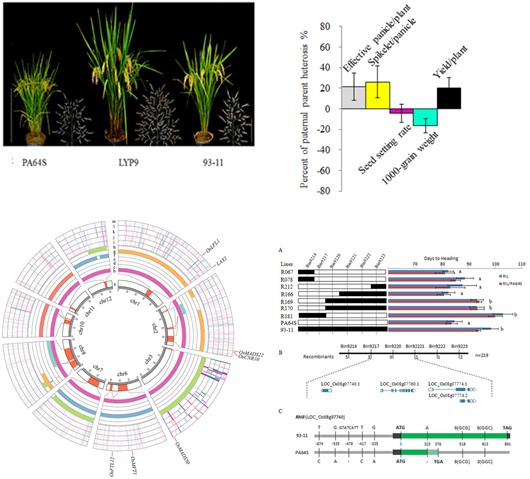PNAS:中科院遗传所朱立煌研究组和袁隆平院士等发表两系杂交稻
2016年9月26日,国际著名学术期刊《美国国家科学院院刊》杂志在线发表了中国科学院遗传与发育生物学研究所朱立煌研究组、曹晓风研究组、梁承志研究组与湖南杂交水稻中心袁隆平研究团队、中国科学院北京基因组所宋述慧研究组和亚热带农业生态所陈彩艳研究组等共7个单位的合作的一篇研究论文,研究论文题为“Integrated analysis of phenome, genome, and transcriptome of hybrid rice uncovered multiple heterosis-related loci for yield increase”。研究论文通过系统遗传学的途径,综合表型组、基因组和转录组等组学信息,通过对二个永久性分离群体的遗传分析和图位克隆揭示了两系杂交稻两优培九的杂种产量优势的关键性状及相关的基因和QTLs。
杂交水稻的推广为我国和世界的粮食安全做出了巨大贡献。但直到目前,杂种优势的分子机制仍然悬而未决。为了探究水稻杂种优势的遗传机制,该团队选用两系超级杂交稻两优培九(LYP9,培矮64s×93-11)为模式组合,对水稻杂种优势的表型及分子基础进行了综合分析。对多个杂交水稻组合的产量优势性状进行多年、多地点的综合分析发现:每穗小花数和有效穗数是造成两系杂交稻产量优势的主要原因;前者有超亲优势,后者只有超父本优势。在对源自LYP9后代的每个重组自交系(RIL)群体进行重测序的基础上,构建了一张高分辨率的遗传连锁图,并利RIL群体及其与母本回交的RILBC1群体进行产量相关性状的遗传定位,鉴定了一系列产量及其他优势相关性状的QTL位点。同时,结合对幼穗发育早期的转录组分析以及QTL定位的结果,确定了多个与杂种优势相关候选基因。该团队还对一个产量杂种优势的主效位点进行了图位克隆,发现rICE heterosis 8 (RH8) 位点实际上是由DTH8/Ghd8/LHD1编码的光周期调控的节律基因,它同时控制开花期、株高、分蘖数,每穗小花数等多种性状。随后对361份杂交稻(其中包括125份二系杂交稻)的基因型解析后发现,RH8的杂合性是两系法杂交稻基因型的主要类型。该团队在此基础上对今后的杂交稻育种方向提出了具体的建议。这项研究对推动杂交稻的分子设计育种实践有重要的意义,利用该研究成果,有望能进一步优化杂交稻亲本材料的选育和配组,选育出更加高产、优质的杂交稻。

图. 通过综合的组学方法揭示两系杂交稻产量杂种优势相关基因和QTLs
原文链接:
Integrated analysis of phenome, genome, and transcriptome of hybrid rice uncovered multiple heterosis-related loci for yield increase
原文摘要:
Hybrid rice is the dominant form of rice planted in China, and its use has extended worldwide since the 1970s. It offers great yield advantages and has contributed greatly to the world’s food security. However, the molecular mechanisms underlying heterosis have remained a mystery. In this study we integrated genetics and omics analyses to determine the candidate genes for yield heterosis in a model two-line rice hybrid system, Liang-you-pei 9 (LYP9) and its parents. Phenomics study revealed that the better parent heterosis (BPH) of yield in hybrid is not ascribed to BPH of all the yield components but is specific to the BPH of spikelet number per panicle (SPP) and paternal parent heterosis (PPH) of effective panicle number (EPN). Genetic analyses then identified multiple quantitative trait loci (QTLs) for these two components. Moreover, a number of differentially expressed genes and alleles in the hybrid were mapped by transcriptome profiling to the QTL regions as possible candidate genes. In parallel, a major QTL for yield heterosis, rice heterosis 8(RH8), was found to be the DTH8/Ghd8/LHD1 gene. Based on the shared allelic heterozygosity of RH8 in many hybrid rice cultivars, a common mechanism for yield heterosis in the present commercial hybrid rice is proposed.
作者:朱立煌

